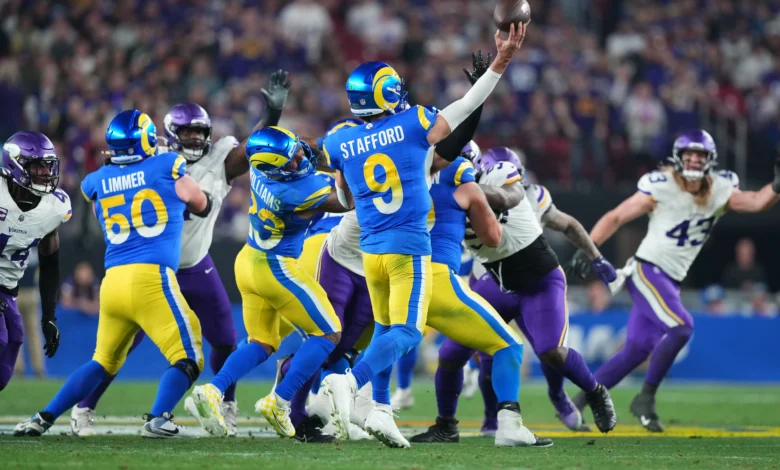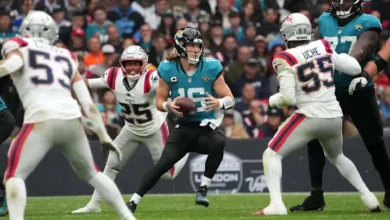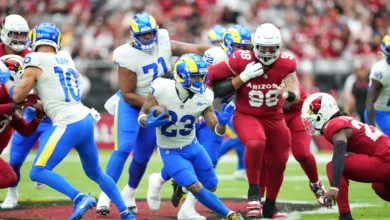Minnesota Vikings vs Los Angeles Rams Match Player Stats: A Complete Breakdown

Introduction
Whenever the Minnesota Vikings take on the Los Angeles Rams, fans expect a tactical battle. Both teams belong to the NFC, and their matchups often carry playoff implications or serve as tests of where each roster stands.
The Vikings, a franchise known for elite receivers and resilient defenses, are currently in a transition phase with youth at quarterback and adjustments on defense. The Rams, revitalized under Sean McVay, continue to innovate offensively while relying on veterans like Matthew Stafford and Cooper Kupp to deliver in key moments.
Their most recent meeting offered the perfect mix of drama, momentum swings, and individual brilliance. While the Rams ultimately secured a 27–20 victory, the game was a study in efficiency, explosive plays, and defensive resilience. By diving into the match player stats, we can see how the outcome was decided and what it says about both franchises moving forward.
Game Overview
The game began with both teams trading blows. Minnesota struck first with a Justin Jefferson touchdown, but the Rams answered through a balanced attack. By halftime, the score was level, but the Rams began to pull away in the third quarter behind Kyren Williams’ hard-nosed running and Matthew Stafford’s precision passing.
The Vikings stayed competitive thanks to Jefferson and rookie quarterback J.J. McCarthy, but a costly interception in the fourth quarter swung momentum to Los Angeles. The Rams leaned on their defense and the reliable connection between Stafford and Kupp to close the contest.
Final Score: Rams 27 – Vikings 20
Team-Level Statistics
| Category | Minnesota Vikings | Los Angeles Rams |
| Total Yards | 354 | 389 |
| Passing Yards | 276 | 302 |
| Rushing Yards | 78 | 87 |
| First Downs | 19 | 23 |
| Third-Down Efficiency | 6/14 (43%) | 7/13 (54%) |
| Turnovers | 1 | 1 |
| Time of Possession | 29:47 | 30:13 |
Key Insights:
The Rams held small but significant advantages in total yards and first downs.
Both sides were evenly matched on turnovers, but Los Angeles capitalized on theirs better.
The third-down numbers show why the Rams were able to sustain drives in the second half.
Quarterback Performance
J.J. McCarthy (Vikings)
Completions/Attempts: 23/35
Passing Yards: 276
Touchdowns: 2
Interceptions: 1
Passer Rating: 95.4
The rookie showed composure under pressure, making accurate throws to Jefferson and Hockenson. His interception late in the fourth quarter, however, killed momentum when Minnesota was pushing for a game-tying drive.
Matthew Stafford (Rams)
Completions/Attempts: 27/39
Passing Yards: 302
Touchdowns: 2
Interceptions: 1
Passer Rating: 97.9
Stafford continues to be the steady veteran presence for Los Angeles. He spread the ball well, with Kupp and Nacua leading the way. His ability to convert on third downs was the difference, keeping Minnesota’s defense on the field.
QB Comparison:
McCarthy impressed with flashes of brilliance but made the key mistake. Stafford was steady, efficient, and delivered when it mattered.
Running Backs
Vikings
Aaron Jones: 15 carries, 62 yards, 1 TD. Averaged 4.1 yards per carry and gave the Vikings balance in the first half.
Ty Chandler: 6 carries, 18 yards. Struggled to find space against the Rams’ front.
Rams
Kyren Williams: 18 carries, 79 yards, 1 TD. His power running in the third quarter wore down Minnesota’s defense.
Ronnie Rivers: 4 carries, 8 yards. Limited involvement, but contributed on special teams.
Analysis:
Williams’ ability to extend drives separated the Rams from the Vikings. Jones was effective but underutilized, especially late when the Vikings leaned too heavily on McCarthy.
Wide Receivers and Tight Ends
Vikings Receiving Corps
Justin Jefferson: 8 receptions, 112 yards, 1 TD. Dominant as always, beating double coverage with route running.
Jordan Addison: 5 receptions, 64 yards. Provided crucial intermediate gains.
T.J. Hockenson (TE): 6 receptions, 54 yards, 1 TD. Reliable in the red zone and on third downs.
Rams Receiving Corps
Cooper Kupp: 9 receptions, 128 yards, 1 TD. The go-to option, especially in clutch moments.
Puka Nacua: 6 receptions, 74 yards. Emerging as a dependable complement to Kupp.
Tyler Higbee (TE): 3 receptions, 31 yards. Added versatility in short-yardage situations.
Insight:
Jefferson and Kupp showcased why they are elite receivers. Both had 100+ yards and a touchdown, highlighting their value as difference-makers. The Rams’ supporting cast, especially Nacua, gave Stafford more consistent options.
Defensive Breakdown
Vikings Defense
Danielle Hunter: 1.5 sacks, multiple QB pressures. Forced Stafford into hurried throws.
Secondary: Struggled to contain Kupp, particularly on third downs.
Rams Defense
Aaron Donald: 2 sacks, 5 QB pressures. A disruptive force who tilted the game in Los Angeles’ favor.
Secondary: Held Addison in check while focusing double teams on Jefferson at key moments.
Analysis:
The Rams’ defensive line outperformed Minnesota’s. Donald’s presence created chaos, while the Vikings could not consistently slow Williams’ running or Kupp’s routes.
Special Teams
Both teams were steady, with no major missed field goals. The Rams’ punter played a pivotal role, pinning Minnesota inside their 10-yard line twice. Those field position swings forced the Vikings into long drives they couldn’t consistently finish.
Key Turning Points
Jefferson’s Early Touchdown: Put the Vikings up and gave McCarthy confidence.
Williams’ Third-Quarter Rushing TD: Shifted momentum to the Rams, breaking a tie.
McCarthy’s Interception: With Minnesota driving to tie, the rookie’s mistake swung control to Los Angeles.
Stafford-to-Kupp Conversion: A clutch third-down pass late sealed the Rams’ victory.
Player of the Game
Cooper Kupp. His 9 catches for 128 yards and a touchdown proved decisive. Time and again, he bailed out Stafford in critical moments.
Close contenders: Kyren Williams for his ground dominance and Aaron Donald for his defensive disruption.
Historical Context
The Vikings and Rams have history dating back to the NFC battles of the 1970s, when both were perennial contenders. In recent decades, their meetings have often featured offensive showcases.
This game reflected those traditions: elite receivers (Jefferson, Kupp), high-level quarterbacking, and defensive stars. While Minnesota rebuilds around youth, Los Angeles remains in “win-now” mode, maximizing Stafford’s remaining prime.
What the Stats Reveal
Vikings: The offense is promising with McCarthy at the helm, Jefferson as the centerpiece, and Hockenson as a safety valve. The defense, however, needs more consistency in the secondary.
Rams: They remain a dangerous team when Stafford, Kupp, and Donald are healthy. Their balance on offense and pressure on defense make them playoff contenders.
Conclusion
The Minnesota Vikings vs Los Angeles Rams match player stats show why the Rams emerged victorious in a 27–20 contest. Stafford’s efficiency, Kupp’s dominance, and Williams’ running provided balance and explosiveness. On defense, Donald reminded everyone why he remains one of the NFL’s most feared players.
The Vikings weren’t without positives: McCarthy showed promise, Jefferson remained elite, and Jones contributed on the ground. But mistakes, particularly the late interception, revealed the gap between a rebuilding team and a playoff-ready opponent.
In the end, the stats confirm what the scoreboard showed: the Rams controlled the critical moments, while the Vikings showed flashes but lacked the finishing power. Both franchises will take lessons forward — the Rams with confidence, the Vikings with hope for the future.



